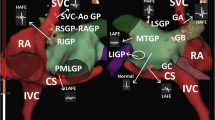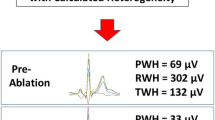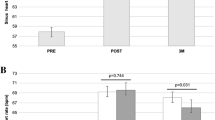Abstract
Purpose
Autonomic modulation following catheter ablation of atrial fibrillation may promote the development of catecholamine-sensitive arrhythmias, such as outflow tract (OT) ventricular premature depolarizations (VPDs). The purpose of this study was to determine the incidence and prognostic significance of OT VPDs occurring in patients after atrial fibrillation (AF) ablation.
Methods
We prospectively examined 53 consecutive patients undergoing wide-area circumferential antral pulmonary vein (PV) isolation; no patients had evidence of OT VPDs on 24 h of preprocedural telemetry monitoring. Cases (OT+) had postprocedure telemetry monitoring with >30 continuous beats or >3/min OT VPDs. Clinical follow-up included transtelephonic monitoring at 6 weeks, 6 months, and 1 year.
Results
The incidence of OT VPDs in this population was 11 % (6/53). There was no difference in AF recurrence at 1 year between those with or without OT VPDs (17 vs 28 %, p = 0.6). There was a strong association with higher immediate postprocedure heart rate (HR) in OT+ compared to OT− patients (86 vs 76, p = 0.03); this difference persisted at 1 year (79 vs 60, p < 0.01). OT VPDs resolved in 5/6 of the OT+ patients over the 1-year follow-up. In a multivariable linear regression model, OT VPDs were associated with higher HR (odds ratio (OR) 1.14 [1.10–1.18], p < 0.001) despite adjustment for medication dose.
Conclusions
A minority of patients undergoing antral PV isolation develops OT VPDs associated with a sustained increase in mean heart rate; this effect may result from the modulation of adjacent autonomic ganglia.



Similar content being viewed by others
Abbreviations
- OT:
-
Outflow tract
- VPD:
-
Ventricular premature depolarization
- AF:
-
Atrial fibrillation
- PVI:
-
Pulmonary vein isolation
- ECG:
-
Electrocardiogram
- AVN:
-
Atrioventricular node
- TTM:
-
Transtelephonic monitor.
References
Bogun, F., Crawford, T., Reich, S., Koelling, T. M., Armstrong, W., Good, E., et al. (2007). Radiofrequency ablation of frequent, idiopathic premature ventricular complexes: comparison with a control group without intervention. Heart Rhythm, 4(7), 863–867.
Sobotka, P. A., Mayer, J. H., Bauernfeind, R. A., Kanakis, C., Jr., & Rosen, K. M. (1981). Arrhythmias documented by 24-hour continuous ambulatory electrocardiographic monitoring in young women without apparent heart disease. American Heart Journal, 101(6), 753–759.
Shotan, A., Ostrzega, E., Mehra, A., Johnson, J. V., & Elkayam, U. (1997). Incidence of arrhythmias in normal pregnancy and relation to palpitations, dizziness, and syncope. American Journal of Cardiology, 79(8), 1061–1064.
Kanei, Y., Friedman, M., Ogawa, N., Hanon, S., Lam, P., & Schweitzer, P. (2008). Frequent premature ventricular complexes originating from the right ventricular outflow tract are associated with left ventricular dysfunction. Annals of Noninvasive Electrocardiology, 13(1), 81–85.
Topaloglu, S., Aras, D., Cagli, K., Yildiz, A., Cagirci, G., Cay, S., et al. (2007). Evaluation of left ventricular diastolic functions in patients with frequent premature ventricular contractions from right ventricular outflow tract. Heart and Vessels, 22(5), 328–334.
Takemoto, M., Yoshimura, H., Ohba, Y., Matsumoto, Y., Yamamoto, U., Mohri, M., et al. (2005). Radiofrequency catheter ablation of premature ventricular complexes from right ventricular outflow tract improves left ventricular dilation and clinical status in patients without structural heart disease. Journal of the American College of Cardiology, 45(8), 1259–1265.
Ito, M., Tsumabuki, S., Maeda, Y., Arita, M., Saikawa, T., Ito, S., et al. (1987). Suppression of ventricular premature contractions possibly related to triggered activity by oral diltiazem and atenolol. Japanese Circulation Journal, 51(2), 217–229.
Saikawa, T., Niwa, H., Ito, M., Ishida, S., Nakagawa, M., Maeda, T., et al. (2001). The effect of propafenone on premature ventricular contractions (PVC): an analysis based on heart rate dependency of PVCs. Japanese Heart Journal, 42(6), 701–711. Clinical trial.
Brodsky, M., Doria, R., Allen, B., Sato, D., Thomas, G., & Sada, M. (1992). New-onset ventricular tachycardia during pregnancy. American Heart Journal, 123(4 Pt 1), 933–941.
Zimmermann, M., & Kalusche, D. (2001). Fluctuation in autonomic tone is a major determinant of sustained atrial arrhythmias in patients with focal ectopy originating from the pulmonary veins. Journal of Cardiovascular Electrophysiology, 12(3), 285–291.
Karch, M. R., Zrenner, B., Deisenhofer, I., Schreieck, J., Ndrepepa, G., Dong, J., et al. (2005). Freedom from atrial tachyarrhythmias after catheter ablation of atrial fibrillation: a randomized comparison between 2 current ablation strategies. Circulation, 111(22), 2875–2880.
Oral, H., Pappone, C., Chugh, A., Good, E., Bogun, F., Pelosi, F., Jr., et al. (2006). Circumferential pulmonary-vein ablation for chronic atrial fibrillation. New England Journal of Medicine, 354(9), 934–941.
Pappone, C., Augello, G., Sala, S., Gugliotta, F., Vicedomini, G., Gulletta, S., et al. (2006). A randomized trial of circumferential pulmonary vein ablation versus antiarrhythmic drug therapy in paroxysmal atrial fibrillation: the APAF study. Journal of the American College of Cardiology, 48(11), 2340–2347.
Doll, N., Pritzwald-Stegmann, P., Czesla, M., Kempfert, J., Stenzel, M. A., Borger, M. A., et al. (2008). Ablation of ganglionic plexi during combined surgery for atrial fibrillation. Annals of Thoracic Surgery, 86(5), 1659–1663. Evaluation studies.
McClelland, J. H., Duke, D., & Reddy, R. (2007). Preliminary results of a limited thoracotomy: new approach to treat atrial fibrillation. Journal of Cardiovascular Electrophysiology, 18(12), 1289–1295. Clinical trial.
Mehall, J. R., Kohut, R. M., Jr., Schneeberger, E. W., Taketani, T., Merrill, W. H., & Wolf, R. K. (2007). Intraoperative epicardial electrophysiologic mapping and isolation of autonomic ganglionic plexi. Annals of Thoracic Surgery, 83(2), 538–541.
Ohkubo, K., Watanabe, I., Okumura, Y., Ashino, S., Kofune, M., Takagi, Y., et al. (2008). Combined effect of pulmonary vein isolation and ablation of cardiac autonomic nerves for atrial fibrillation. International Heart Journal, 49(6), 661–670.
Po, S. S., Nakagawa, H., & Jackman, W. M. (2009). Localization of left atrial ganglionated plexi in patients with atrial fibrillation. Journal of Cardiovascular Electrophysiology, 20(10), 1186–1189. Review.
Hutchinson, M. D., Garcia, F. C., Mandel, J. E., Elkassabany, N., Zado, E. S., Riley, M. P., et al. (2013). Efforts to enhance catheter stability improve atrial fibrillation ablation outcome. Heart Rhythm, 10(3), 347–353.
Hsieh, M. H., Chiou, C. W., Wen, Z. C., Wu, C. H., Tai, C. T., Tsai, C. F., et al. (1999). Alterations of heart rate variability after radiofrequency catheter ablation of focal atrial fibrillation originating from pulmonary veins. Circulation, 100(22), 2237–2243.
Pappone, C., Santinelli, V., Manguso, F., Vicedomini, G., Gugliotta, F., Augello, G., et al. (2004). Pulmonary vein denervation enhances long-term benefit after circumferential ablation for paroxysmal atrial fibrillation. Circulation, 109(3), 327–334.
Nilsson, B., Chen, X., Pehrson, S., Hilden, J., & Svendsen, J. H. (2005). Increased resting heart rate following radiofrequency catheter ablation for atrial fibrillation. Europace, 7(5), 415–420.
Funding
This work was supported in part by the F. Harlan Batrus Research Fund.
Conflict of interest
The authors declare no relevant conflicts of interest.
Author information
Authors and Affiliations
Corresponding author
Electronic supplementary material
Below is the link to the electronic supplementary material.
ESM 1
(DOCX 23 kb)
Rights and permissions
About this article
Cite this article
Patel, P.J., Ahlemeyer, L., Freas, M. et al. Outflow tract premature ventricular depolarizations after atrial fibrillation ablation may reflect autonomic influences. J Interv Card Electrophysiol 41, 187–192 (2014). https://doi.org/10.1007/s10840-014-9914-y
Received:
Accepted:
Published:
Issue Date:
DOI: https://doi.org/10.1007/s10840-014-9914-y




